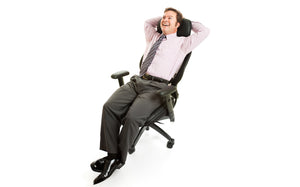Office chairs in the current age offer a wide range of adjustability. A back tilt on an office chair refers to the functionality that allows the user to recline or lean back in the chair. Depending on the specific model, this may involve the whole seat tilting back or just the backrest. The back tilt mechanism is designed to improve comfort, reduce fatigue, and promote better posture by accommodating different sitting positions.
There are different types of tilt mechanisms with different degrees of adjustability, and understanding these can help you find the most comfortable and supportive chair for your needs.
-
Center Tilt: The center tilt allows the chair to tilt from a point under the center of the chair. This mechanism usually tilts the seat and backrest as a single unit, maintaining the same angle between your body and the seat as you recline.
-
Synchro Tilt: This mechanism allows the backrest and seat to tilt in a synchronized manner but at different ratios. Typically, the backrest reclines at a higher ratio compared to the seat. For example, a 2:1 ratio means the backrest reclines twice as much as the seat. This helps keep your feet on the floor as you recline and maintain a more ergonomic position.
-
Knee Tilt: A knee tilt mechanism allows the chair to tilt from a point close to the front of the seat, which keeps your feet on the ground while enabling a deeper recline. This is often found on executive or high-end office chairs.
-
Multi-Tilt: The multi-tilt mechanism allows the seat and back to tilt independently of each other, providing the greatest level of adjustability. You can adjust the angle of the seat and backrest separately, allowing for a wide range of positions.
-
Forward Tilt: Some chairs offer a forward tilt mechanism that allows the seat to tilt forward. This can be helpful when doing tasks that require you to lean into your desk, such as typing or writing.
The tilt tension adjustment is another feature that's often included with these mechanisms. It allows you to adjust the amount of resistance when you lean back, which means you can make it easier or harder to recline depending on your preference.
Tilt lock is a feature that enables the user to lock the chair in a particular tilt position. Once the chair is reclined to a desired angle, activating the tilt lock will secure the chair in that position, providing consistent support and comfort. This can be especially useful for tasks that require leaning back, like long phone calls, or for short relaxation breaks.
Remember, everyone's body and work habits are different, so the best tilt mechanism for you will depend on your personal comfort and the type of work you do.

